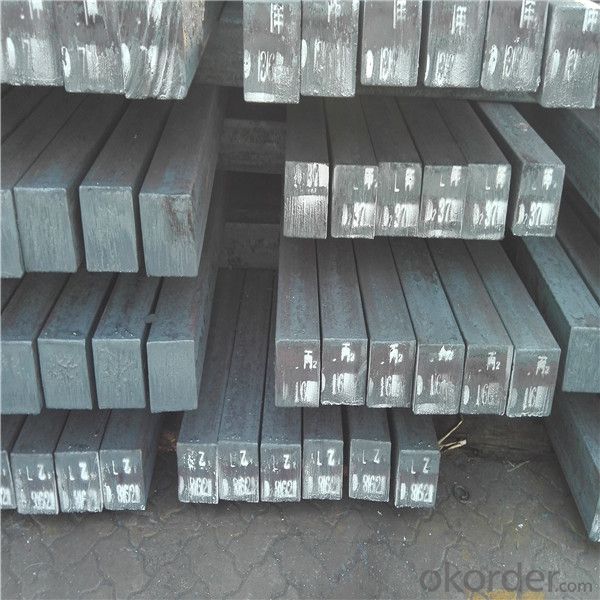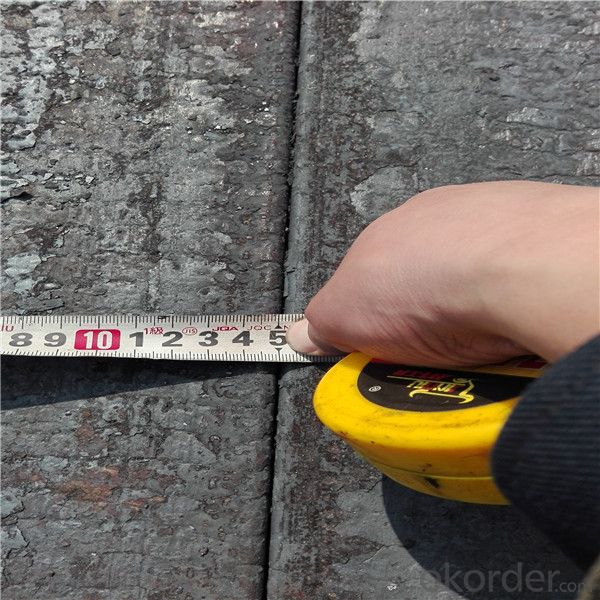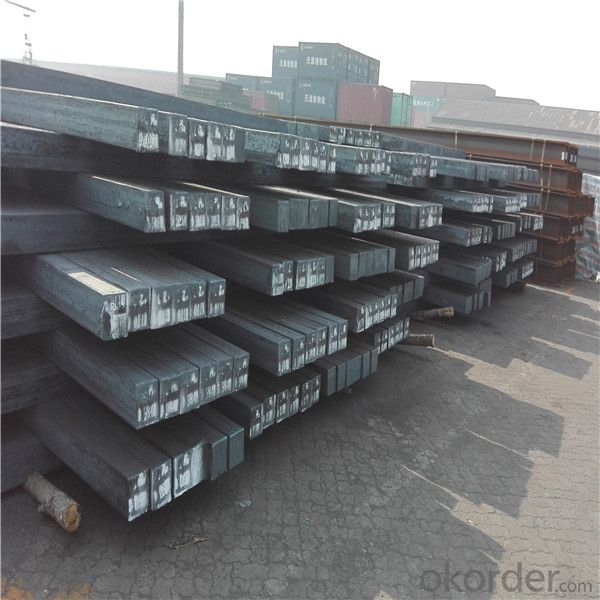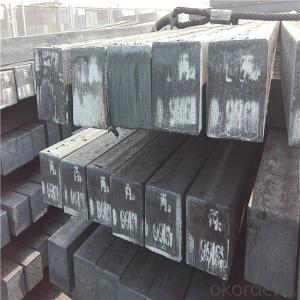Mild steel billet in China Q215/Q195/Q235/Q275
- Loading Port:
- Guangzhou
- Payment Terms:
- TT OR LC
- Min Order Qty:
- 1000 m.t.
- Supply Capability:
- 24531 m.t./month
OKorder Service Pledge
OKorder Financial Service
You Might Also Like
Item specifice
Steel billet
Steel billets have distinct characteristics as compared with already furnished steel bars and products. Billets
have a specific grain structure, which enables the metal to be processed more intricately. Steel billets are also
known for their malleability and ductility, especially when exposed to varying temperatures during shaping and molding.
Billet: equal cross section width and height, or a huge difference, mainly used for rolling steel, wire rod. ,
Tolerance: Strictly according to the G/B and JIS standard
Delivery time: within 45 days after receiving the L/C or advanced T/T payment.
Payment terms: 100%Irrevercable L/C at sight or T/T
Gade:
Standard | C(%) | Mn(%) | S(%) | P(%) | Si(%) |
Q195 | ≤0.12 | ≤0.50 | ≤0.040 | ≤0.035 | ≤0.30 |
Q235 | ≤0.20 | ≤1.40 | ≤0.045 | ≤0.045 | ≤0.35 |
Q275 | ≤0.22 | ≤1.50 | ≤0.045 | ≤0.045 | ≤0.35 |
20MnSi | 0.17-0.25 | 1.2-1.6 | ≤ 0.050 | ≤ 0.050 | 0.40-0.80 |
3SP | 0.14-0.22 | 0.40-0.85 | ≤ 0.050 | ≤ 0.040 | 0.05-0.15 |
5SP | 0.28-0.37 | 0.50-1.00 | ≤ 0.050 | ≤ 0.040 | 0.15-0.30 |



Our service :
We have a plant and professional team to provide our best service, from the start of production until the
loading into the vessel, we have a complete quality follow up procedure, to assure our products arrives to the customer with satisfaction. Welcome new and old customers
to contact us for future business relationships! We will give you a surpise price.
Packing :
Within 30 days
1.Standard export package
2.In bundles with steel strips
3.As the requirements of the customers
FAQ:
Q: What is payment terms?
A: FOB 30% T/T IN ADVANCE AS DEPOSIT AND 70% T/T BEFORE SHIPMENT
CIF and CFR 30% T/T IN ADVANCE AS DEPOSIT AND 70% T/T AS THE COPY OF B/L OR L/C AT SIGHT
Q:How to guarantee the quality of the products?
A:We have established the international advanced quality management system,every link from raw material
to final product we have strict quality test;We resolutely put an end to unqualified products flowing into the market.
At the same time, we will provide necessary follow-up service assurance.
Q:How long can we receive the product after purchase?
A :In the purchase of product within three working days, We will arrange the factory delivery as soon as possible.
The pecific time of receiving is related to the state and position of customers.
- Q:What is the maximum temperature that a steel billet can withstand?
- The maximum temperature that a steel billet can withstand depends on the specific type of steel and its composition. However, as a general rule, most steel billets can withstand temperatures up to around 1,300 to 1,500 degrees Celsius (2,372 to 2,732 degrees Fahrenheit) before experiencing significant structural changes or damage.
- Q:What are the main factors affecting the hardenability of stainless steel billets?
- The hardenability of stainless steel billets, which refers to the material's ability to be hardened through heat treatment, can be influenced by various factors. These factors include: 1. Alloy composition: The composition of stainless steel, especially the presence of carbon, chromium, nickel, and molybdenum, plays a crucial role in determining its hardenability. Higher carbon content generally improves hardenability, while elements like chromium and nickel enhance corrosion resistance but may decrease hardenability. 2. Grain size: The grain size of stainless steel billets affects the rate and depth of hardening. Finer grain structures typically exhibit better hardenability compared to coarser ones. This is because smaller grains allow for a more even distribution of carbon and alloying elements, resulting in improved hardening response. 3. Heat treatment conditions: The specific heat treatment process utilized, including heating and cooling rates, soaking time, and quenching media, has a significant impact on the hardenability of stainless steel billets. Proper control of these parameters is essential to achieve the desired hardness and mechanical properties. 4. Cooling rate: The rate at which the billets are cooled during the quenching process is a critical factor in determining their hardenability. Rapid quenching, such as water or oil quenching, promotes martensitic transformation and leads to greater hardness. Slower cooling rates, such as air cooling, result in a softer and less hardened structure. 5. Cross-sectional thickness: The thickness of the stainless steel billets also affects their hardenability. Thicker sections tend to have lower hardenability due to slower heat transfer rates during quenching. Conversely, thinner sections can achieve higher hardness levels due to faster cooling rates. 6. Prior microstructure: The initial microstructure of the stainless steel billets, whether they are in an annealed or cold-worked state, can influence hardenability. Cold work can introduce dislocations and grain boundaries, which may impede the diffusion of carbon and alloying elements during heat treatment, leading to reduced hardenability. Considering these factors, manufacturers and engineers must carefully select stainless steel grades and tailor the heat treatment process to achieve the desired level of hardenability and mechanical properties in stainless steel billets.
- Q:What are the different heat treatment processes for alloy steel billets?
- Alloy steel billets can undergo various heat treatment processes depending on the desired properties and intended application. Some commonly used processes include: 1. Annealing: The billets are heated to a specific temperature and slowly cooled, typically in a furnace. This relieves internal stresses and improves machinability. 2. Normalizing: Similar to annealing, but the cooling is done in still air. It refines the grain structure and enhances mechanical properties like strength and hardness. 3. Quenching and tempering: The heated alloy steel is rapidly cooled in a liquid medium, such as oil or water, to achieve high hardness and strength. Subsequently, the billets are reheated to a lower temperature to reduce brittleness and improve toughness. 4. Precipitation hardening: This process is suitable for alloy steels containing elements like aluminum, copper, or titanium. It involves a series of heat treatments that cause fine particles to form within the steel, resulting in improved strength and hardness. 5. Case hardening: Used to increase the hardness of the outer layer of the billets, this surface heat treatment process involves heating in the presence of a carbon-rich atmosphere or applying a carbon-rich compound. It is followed by quenching and tempering. These are just a few examples of the many heat treatment processes available for alloy steel billets. The choice depends on factors such as alloy composition, desired properties, and intended application. It is essential to carefully consider these factors and seek advice from heat treatment experts to achieve the desired outcome.
- Q:How are steel billets used in the production of construction components?
- Steel billets are an essential raw material in the production of construction components. They are primarily used in the manufacturing of various structural elements such as beams, columns, and bars that form the framework of buildings and infrastructure projects. The process begins with steel billets, which are semi-finished products made from molten steel that has been cast into rectangular or square shapes. These billets are then further processed and transformed into specific construction components through various manufacturing techniques. One common application of steel billets is in the production of beams, which are essential for supporting the weight of floors, roofs, and walls in buildings. Billets are processed through rolling mills, where they are heated and passed through a series of rollers to shape them into the desired beam profile. This process allows for the production of beams of different sizes and lengths, catering to the unique requirements of each construction project. Steel billets are also used in the production of columns, which provide vertical support to structures. Similarly to beams, billets are processed through rolling mills to obtain the required column shape. The columns are then joined to the beams to form the skeletal framework of the building, providing strength and stability. In addition to beams and columns, steel billets are employed in the production of bars used for reinforcing concrete. These reinforcing bars, commonly known as rebar, are crucial for enhancing the strength and durability of concrete structures. Billets are again processed through rolling mills to create rebar of various diameters and lengths. The rebar is then embedded within the concrete to provide tensile strength, preventing cracking and increasing the overall structural integrity. Overall, steel billets play a vital role in the production of construction components by serving as the starting point for the manufacturing process. They are transformed into beams, columns, and rebar, providing the necessary strength and stability required in the construction of buildings and infrastructure projects.
- Q:What is the average weight of a steel billet?
- The average weight of a steel billet varies depending on its dimensions and specific grade. However, a typical range for the average weight of a steel billet is between 1,000 and 5,000 pounds.
- Q:Can steel billets be used in the manufacturing of machinery?
- Yes, steel billets can be used in the manufacturing of machinery. Steel billets are semi-finished products that can be further processed into various shapes and sizes for different applications. In machinery manufacturing, steel billets are often used as raw materials to produce components such as gears, shafts, and structural frames. The high strength and durability of steel make it an ideal choice for machinery that requires robust construction and reliable performance.
- Q:What are the potential applications of steel billets in the aerospace aftermarket?
- Steel billets have a wide range of potential applications in the aerospace aftermarket. These applications include but are not limited to the production of various aerospace components such as engine parts, airframe structures, landing gear components, and fasteners. One potential application of steel billets in the aerospace aftermarket is the manufacturing of engine parts. Steel billets can be used to produce critical components such as turbine blades, compressor discs, and shafts. These parts require high strength, durability, and resistance to extreme temperatures, all of which can be achieved through the use of steel billets. Additionally, steel billets can be used to produce exhaust system components, such as manifolds and flanges, which also require high temperature resistance. Another important application of steel billets in the aerospace aftermarket is in the production of airframe structures. Steel billets can be utilized to manufacture various structural components, including beams, frames, and brackets. These components are crucial for providing strength and stability to the aircraft's fuselage, wings, and other structural elements. Steel billets offer the necessary strength-to-weight ratio, corrosion resistance, and fatigue resistance required for these demanding applications. Furthermore, steel billets can be used to produce landing gear components in the aerospace aftermarket. Landing gear plays a critical role in the safe operation of an aircraft, and it must withstand significant loads and stresses during takeoff, landing, and taxiing. Steel billets can be machined into landing gear parts such as axles, struts, and wheels, which require high strength, toughness, and fatigue resistance. Lastly, steel billets find applications in the production of fasteners used in the aerospace aftermarket. Fasteners such as bolts, screws, and nuts are essential for joining various components together in an aircraft. Steel billets can be forged or machined into high-strength fasteners that can withstand the high loads and vibrations experienced during flight. In summary, steel billets have numerous potential applications in the aerospace aftermarket. From engine parts to airframe structures, landing gear components, and fasteners, steel billets provide the necessary properties required for the demanding aerospace industry, including strength, durability, temperature resistance, and fatigue resistance.
- Q:How are steel billets used in the manufacturing of energy sector components?
- Steel billets are crucial in the production of various components used in the energy sector. These billets are typically created through continuous casting, a process where liquid steel is poured into a mold and solidifies into a long, rectangular shape. Within the energy sector, steel billets are the primary raw material for manufacturing a wide range of components. One common application is in the production of pipelines. These billets are heated and then rolled or forged to create seamless or welded pipes, which are used to transport oil, gas, and other fluids over long distances. The strength and durability of steel make it an excellent material for pipelines, ensuring the safe and efficient transportation of energy resources. Steel billets also play a role in the production of power generation equipment. They are shaped and machined into components such as turbine blades, shafts, and rotors, which are vital for power plant operation. Steel's exceptional mechanical properties, including high tensile strength and corrosion resistance, make it suitable for withstanding the harsh conditions and high temperatures experienced in power generation processes. Moreover, steel billets are used in the manufacturing of renewable energy infrastructure, like wind turbine towers. These billets are transformed into large cylindrical sections that provide structural support for wind turbines. The strength and stability of steel guarantee that wind turbines can withstand the forces exerted by the wind and efficiently generate electricity. In conclusion, steel billets are essential in the energy sector as they serve as raw materials for pipelines, power generation equipment, and renewable energy infrastructure. Their strength, durability, and resistance to corrosion make them ideal for enduring demanding conditions and ensuring the reliability of energy sector components.
- Q:How are steel billets used in the manufacturing of renewable energy equipment?
- Steel billets are an essential component in the manufacturing of renewable energy equipment. These billets are first melted and shaped into a specific form, typically a square or rectangular shape, through a process called casting. Once the billets are formed, they undergo further processing and shaping to create the necessary components for renewable energy equipment. In wind energy, for example, steel billets are used to manufacture the tower structures that support the wind turbines. These towers need to be strong and sturdy to withstand the harsh environmental conditions and support the weight of the turbine. Steel billets provide the necessary strength and durability to construct these towers, ensuring the longevity and reliability of the wind turbines. Similarly, in solar energy, steel billets are used in the manufacturing of solar panels and mounting structures. Solar panels require frames made of steel to support the photovoltaic cells and protect them from external factors. Additionally, steel billets are used to construct the mounting structures that hold the solar panels in place, allowing them to capture sunlight efficiently. Steel billets are also used in the production of hydroelectric power equipment. For instance, they are utilized in the construction of turbines and other components that are submerged in water. These billets need to have excellent resistance to corrosion and high strength to withstand the extreme conditions and forces present in hydroelectric power plants. Moreover, steel billets are employed in the manufacturing of components for other types of renewable energy equipment, such as geothermal power plants and biomass energy systems. They are used in various applications, including structural supports, heat exchangers, and boilers, where their strength and durability are crucial. In summary, steel billets play a vital role in the manufacturing of renewable energy equipment. Their strength, durability, and resistance to corrosion make them an ideal material for constructing the essential components of wind turbines, solar panels, hydroelectric power plants, and other renewable energy systems. By providing the necessary structural integrity, steel billets contribute to the efficient and reliable operation of renewable energy equipment, enabling the transition to a more sustainable and eco-friendly energy future.
- Q:How do steel billets contribute to the sustainability of construction projects?
- Steel billets contribute to the sustainability of construction projects in several ways. First, steel is an incredibly durable and long-lasting material. Steel billets are the raw form of steel that can be used to manufacture various construction components such as beams, columns, and reinforcement bars. These components provide structural integrity and strength to buildings, ensuring their longevity. By using steel billets, construction projects can be built to withstand extreme weather conditions and natural disasters, reducing the need for frequent repairs or replacements. This durability directly contributes to the sustainability of construction projects by reducing waste and conserving resources over time. Second, steel is a highly recyclable material. Steel billets can be recycled and reused indefinitely without losing their quality or performance. Recycling steel reduces the energy consumption, greenhouse gas emissions, and waste associated with the production of new steel. By incorporating recycled steel billets into construction projects, the demand for virgin steel can be reduced, thereby conserving natural resources and minimizing environmental impact. Additionally, the use of steel billets in construction allows for efficient and versatile designs. Steel is known for its high strength-to-weight ratio, allowing for lighter and slimmer structural elements that require fewer materials. This not only reduces the overall weight of the building, but also decreases the amount of concrete and other construction materials required. As a result, less energy is consumed in the production and transportation of these materials, leading to a more sustainable construction process. Furthermore, steel is resistant to pests, such as termites and fungi, which can cause significant damage to buildings. By using steel billets, construction projects can avoid the use of chemical treatments typically required to protect wooden structures, reducing the environmental impact of pest control measures. In conclusion, steel billets contribute to the sustainability of construction projects through their durability, recyclability, efficient design possibilities, and resistance to pests. By incorporating steel into construction, buildings can be built to last, reduce waste, conserve resources, and minimize environmental impact.
1. Manufacturer Overview |
|
|---|---|
| Location | |
| Year Established | |
| Annual Output Value | |
| Main Markets | |
| Company Certifications | |
2. Manufacturer Certificates |
|
|---|---|
| a) Certification Name | |
| Range | |
| Reference | |
| Validity Period | |
3. Manufacturer Capability |
|
|---|---|
| a)Trade Capacity | |
| Nearest Port | |
| Export Percentage | |
| No.of Employees in Trade Department | |
| Language Spoken: | |
| b)Factory Information | |
| Factory Size: | |
| No. of Production Lines | |
| Contract Manufacturing | |
| Product Price Range | |
Send your message to us
Mild steel billet in China Q215/Q195/Q235/Q275
- Loading Port:
- Guangzhou
- Payment Terms:
- TT OR LC
- Min Order Qty:
- 1000 m.t.
- Supply Capability:
- 24531 m.t./month
OKorder Service Pledge
OKorder Financial Service
Similar products
New products
Hot products
Related keywords




























